The lit cultivation of tomatoes has increased strongly in Northwest Europe in recent years. In the Netherlands, more than 60% of the cultivated area is already under lights in winter.
Increasing the scale of these lit growers means that production has to be spread, which also means planting dates are spread. For propagators this means a higher possession in summertime.
Many might think it’s nice to have the nursery filled up which is true, but propagating tomato plants in the summer is a true specialism. The biggest issues are high night temperatures (> 16°C) and high radiation levels ( > 750 Watts) during the summer days, shares Hans van Herk of Propagation Solutions.
He gives (inter)national cultivation advice especially for propagation companies and calls the increasing volume of plants in summer a positive development that also involves (new) challenges. Below, Hans explains these and goes through the propagation process.
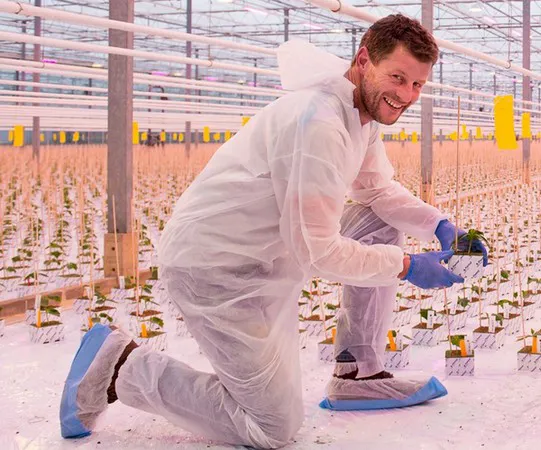
Singles in the Netherlands
In the Netherlands, the highly specialised business of growing tomatoes in conditions under lights is only done by a limited number of specialists. They took their lead years ago when plants with 2-3 flowering trusses were still being delivered, and a number of their customers were growing strongly in terms of lit cultivation. They have never let go of that specialisation.
The rising prices from mid-October to the beginning of November have increased the popularity of early cultivation under lights. As a result, a relatively large number of plants are planted from mid-August onwards, which leads to peaks in possession, labour, etc. at propagators in the middle of summer.
From sowing to grafting
After his general introduction, Hans immediately goes in depth. Summer crops are ok, but will it be grafted - pinched on the cotyledons or a grafted- pinched plant on the 2nd or 3rd leaf? Once the cultivation has been properly planned, it turns out that it is or will be 30°C for days on end, even in the Westland. What should you do in this situation, because the plants grow very fast?
A strongly underestimated factor for the growth of plants is distance or density per square metre. Spacing plants is extremely important, and the beauty of it is that a small area is enough. Even days with over 3,000 Joules in Australia or Greece have less influence than keeping young plants too close together. A high density provides a humid micro-climate which is stronger than the radiation. Consequences of this are stretched plants, too thin and difficult to graft and poor cluster formation and an extended cluster initiation.
For a plant, distance means more evaporation, more focus on roots and, as a result, more compact growth. That is also what the grower wants. The ultimate goal for a crop grown under lights is, in principle, a healthy, compact and nearly flowering plant. Every form of stretching is therefore undesirable, emphasises Hans. This starts very early on. Plants are selected after 7-8 days, both for rootstock and cultivated varieties. For these actions, of course, the space, machinery and good timing must be available. Specialist knowledge and experience are definitely an advantage here, is Hans' experience.
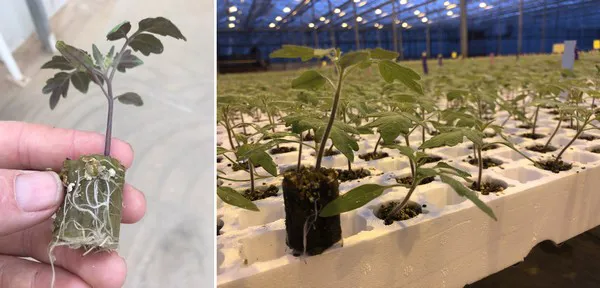
Left: Strong, graftable rootstock. Right: Tomatoes at a young age.
Difficult conditions in summer for pinched plants
The plant type most commonly used in North-Western Europe is a pinched plant on 2 or 3 true leaves. This creates a plant with 2 heads or 3 heads. The characteristics of a hot summer, high radiation intensity (> 750 Watt) and high night temperatures (> 16°C) are unfavourable for the plants.
The warm nights make the plants stretch and they become weaker. The high radiation results in an explosion of assimilates; the plants cannot run away from this and absorb everything. The picture that then emerges is of leaves that are strongly curled, very dark green in colour and lots of purple on the stem.
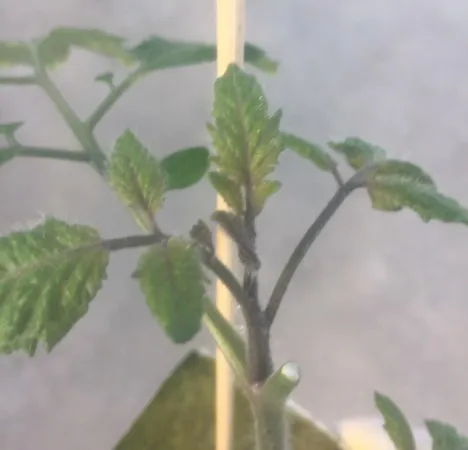
Shoot with a surplus of assimilates
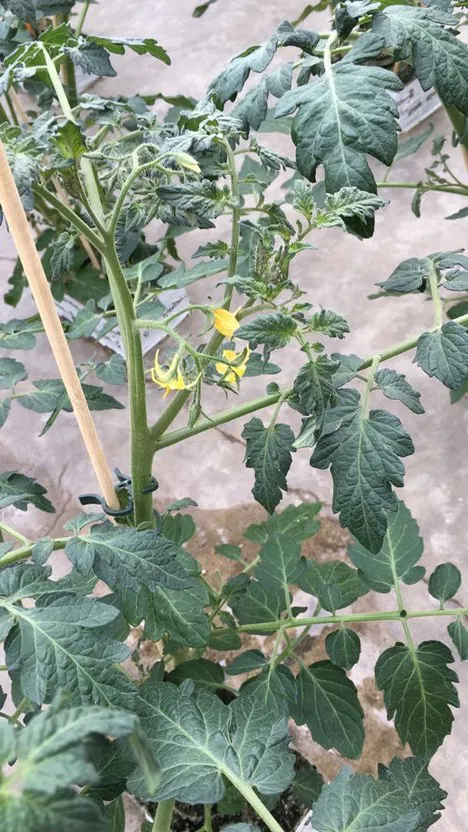 In the first week after pinching, the risk of this is very high, the chance of headlessness after the first truss is also very high. The 1st truss is already initiated 3-4 days after pinching. But this is only visible at the end of the cultivation, a missed opportunity...
In the first week after pinching, the risk of this is very high, the chance of headlessness after the first truss is also very high. The 1st truss is already initiated 3-4 days after pinching. But this is only visible at the end of the cultivation, a missed opportunity...
Picture on the right: headlessness after the 1st truss, click here to enlarge
Solutions to reduce the amount of light & the peaks in radiation include:
- Reduce the amount of hours and let it drop quickly on radiation (> 200 Watt);
- Screens during the radiation peak between 10.30 and 15.00;
- and using sun protection / diffuse products on the greenhouse roof.
Generative control
Nevertheless, the plants must be steered generatively because otherwise the formation of the 2nd truss will be delayed after pinching and there will be 4-5-6 leaves between truss 1 (after 6 leaves) and truss 2. For this, distance between the blocks is essential, a solid Dif in temperature is certainly good but insufficient on its own. The vegetative microclimate created by the moisture from the blocks is responsible for this. Varieties with a fruit weight > 125 grams are even more sensitive to this.
Generative steering prevents the plants from stretching, something that is experienced as very negative by the growers. Stretching of the stems can never be reversed. The nurseryman achieves generative steering by spacing out the plants shortly after pricking out the grafted plants. This can be done with just a few centimetres between the blocks. There is more air movement around the plants, the microclimate around the plants becomes drier and the plants have to work harder. All this keeps them compact and generative, which is exactly what is intended.
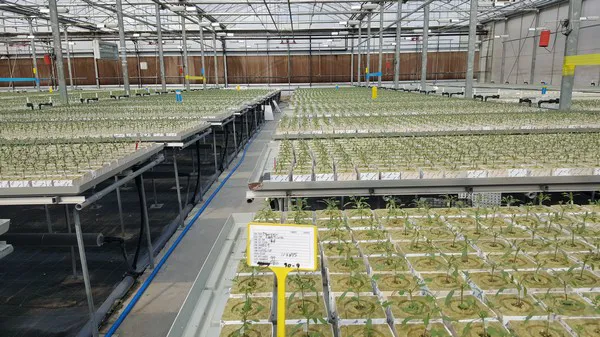
Pinched tomatoes on a short distance in summer Greece
A week after pinching, the risk of blind plants is over, and the 2nd truss has been initiated. The plants must then be moved to final distances such as 6-7 plants / m² for 2-headers, although it is of course also possible to use an interim density. Again, we need to switch. The temperature has to be get a larger Dif, the hours of light have to be increased and the number of hours of screen time against the sun has to be reduced as well. The plants have to work hard, but this also keeps them compact and generative. The ultimate goal, compact, a high level of energy / assimilates and almost flowering, is then in sight with about two weeks to go before delivery.
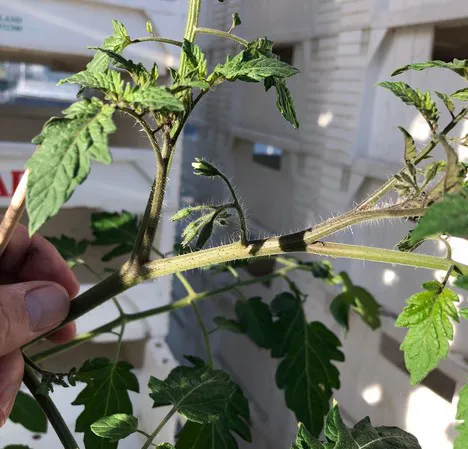
Strong, generative plant that is almost flowering with the 2nd cluster on 3 leaves.
All in all, propagating tomato plants for lit crops while summer is in full swing is a very specialised task, as Hans shows above in words and pictures. There are many adjustments to be made along the way. This means that experience and knowledge are strongly needed to propagate successfully in the middle of the summer. And that is what Hans, who assists nurseries worldwide, will be doing in the near future.
For more information:
Hans van Herk 
Propagation Solutions
[email protected]
+31 (0)6 20 91 81 00
